
Birding Around Las Vegas, Outside the Las Vegas Valley

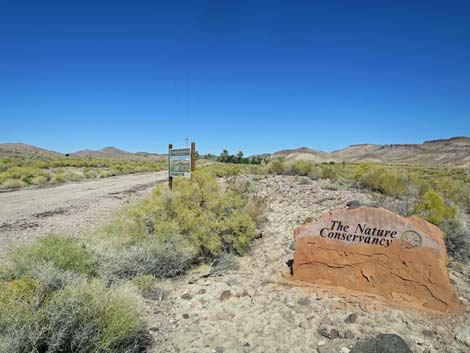 Torrance Ranch sign inside entrance gate (view NE) |
Overview Torrance Ranch Preserve, a 130-acre Nature Conservancy Area just north of Beatty, Nevada, was established to protect springs and riparian areas at the headwaters of the Amargosa River. The water, in turn, supports rare Amargosa Toads and Oasis Valley Speckled Dace, plus a variety of other wildlife and birds. Located about 2 hrs north of Las Vegas, Torrance Ranch Preserve isn't a birding destination. Rather, this is a place to stop along the highway, relax for a few minutes under the trees, stretch the legs, and spot a few interesting birds before driving on. There are no restrooms. Please help protect the land, vegetation, and wildlife here. Don't play in the water, as this will disturb the rare toads and fish. There are three areas to bird: the parking area, the boardwalk, and the old highway. Link to site map. |
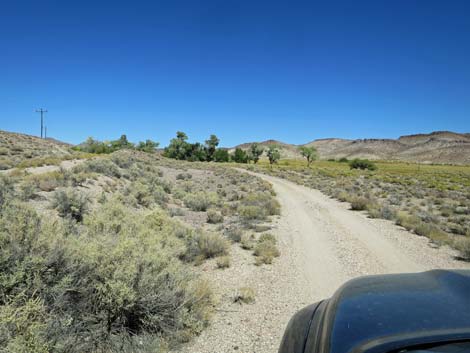 Torrance Ranch Road (view N) |
Description Torrance Ranch Preserve was a homesite on the edge of a marsh in the bottom of a desert valley. A fairly smooth road leads from the highway to the site of the old ranch house, which is gone. Trails and a boardwalk lead from the parking lot into the area, providing access to about 20 acres of the preserve. Most historic structures are gone, but trees and shrubs from home landscaping (apple, pear, pomegranate, pine, and cypress) remain in the area. There is also a variety of desert riparian (cottonwood, willow) and native upland plant species. The water and fruit, plus vegetation for cover, makes this is a good place for migrating birds to stop and rest during their journey. The big trees also provide nesting habitat for Great Horned Owls and songbirds. |
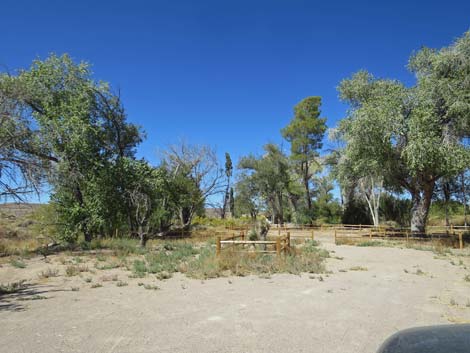 Parking at the end of the road (view N) |
Good places to bird include the cottonwoods and other trees at the end of the road, the marsh east of the picnic area, and the willow thickets and spring pools north of the trailhead. Walking into the area, birders will encounter a kiosk with information about the area and a site map. To the right of the kiosk, a rock-lined trail (the Boardwalk Trail) leads northeast towards to a sign with more information about the habitat and species that are protected here. Farther out the trail, a boardwalk leads into the marsh where grasses and hydrophilic plants provide habitat for fish, birds, and other species. A line of bulrushes and cattails mark the small stream, and willows are growing up around the dace pool. Watch for birds in the sky (e.g., swallows and hawks) and the marsh (wrens and sparrows). Listen for the calls of toads, and look for fish in the water. Near where the boardwalk begins, watch for a faint trail that forks off to the left (north). This is the other end of the boardwalk trail. |
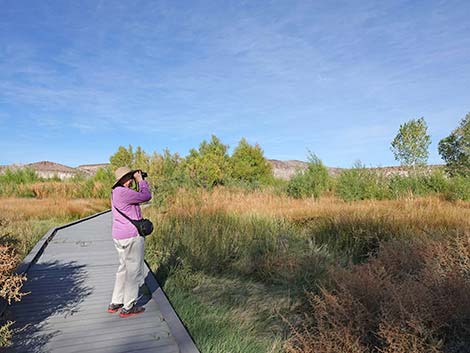 Birding the boardwalk (view N) |
Back at the kiosk, a trail runs left and out onto the old highway, which serves as the Old Highway Trail. Just across the old road, a wide gully is partially blocked by a low cement dam. Springs provide a trickle of water that feeds a small pool here with aquatic vegetation that seems to be a good place to find sparrows, and keep an eye out for toads. The Old Highway Trail runs north providing elevated views over marshes on both sides of the road. A line of trees and willows along the dike stretches north for about 400 yards. The north end of the area burned a few years ago, but this served to clear some brush, but the trees are growing back. This is a good area to look for migrating birds feeding and resting in the trees. Just beyond the willows, but before the fence, the stone walls of an historic cabin sit on a little bluff overlooking the marsh; this would have been a nice place to live. Walking into the marsh beyond the cabin, birders in sensible shoes will find another spring pool with fish, but birding from afar might be a better idea. |
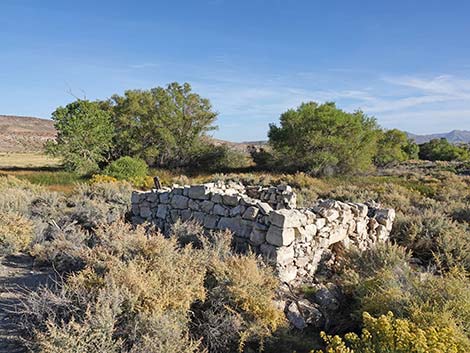 Birding the north end (view SE) |
The surrounding area harbors sparse, dry desert scrub. Between the wet marsh and the dry desert, plant species such as saltbush, desert-thorn, saltgrass, greasewood, and rabbitbrush provide more habitat for sparrows and other desert birds. While in the Area Consider birding around the town of Beatty. The Amargosa River flows through town, and people can bird the trees and riparian corridor on the south edge of town. Highway traffic in this area can be too fast, so stay clear of the road edge. Also, Beatty Urban Pond, also known as Bombo's Pond, is located just south of the narrows outside of Beatty. The cattail fringed pond is visible from the highway and provides habitat for more birds. Fishermen use the pond, so it isn't usually a good place to see waterfowl, but desert species and migrants will come in for water. |
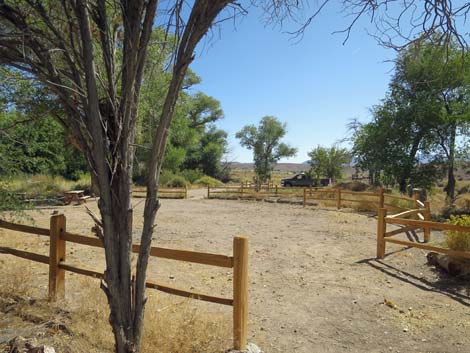 Returning to the picnic and parking areas (view S) |
Location Torrance Ranch Preserve is located on Highway 95, about 120 miles northeast of Las Vegas. To get there from Las Vegas, drive north on Highway 95 for about 2 hours to Beatty. From the stop sign in Beatty, continue another 7.2 miles to Oleo Road and Torrance Ranch Road. There are no signs visible from the highway. For details of getting to Torrance Ranch, see Torrance Ranch Access. Hours Always open, but this area should be considered day-use only. Fees None. |
 Nearby places: Hwy 95 northbound approaching Beatty (view N) |
Torrance Ranch Preserve is a good area to find a variety of desert and riparian species. Check the trees and willow thickets for warblers, sparrows, flycatchers, and other migrants, including Wilson's Warbler, MacGillivray's Warbler, Northern Parula, Yellow Warbler, White-breasted Nuthatch, Lincoln Sparrow, Warbling Vireo, Mourning Dove, and Bullock's Orioles. Vermilion Flycatchers have been seen here. Great Horned Owls seem to be resident. Check the marshy areas for Marsh Wrens, Violet-green Swallows, Tree Swallows, Red-tailed Hawks, Common Raven, Killdeer, and Lark Sparrows. Keep an eye out for other species such as Amargosa Toads, Oasis Valley Speckled Dace (but don't trample the marshy vegetation trying to get a better view), and Wild Burro. There are several kinds of lizards here (e.g., Western Whiptail, Zebra-tailed Lizard, Western Fence Lizard, and Side-blotched Lizards). Keep an eye out for snakes too, especially the Great Basin Rattlesnakes that live in the area. |
Birding the Parking Area
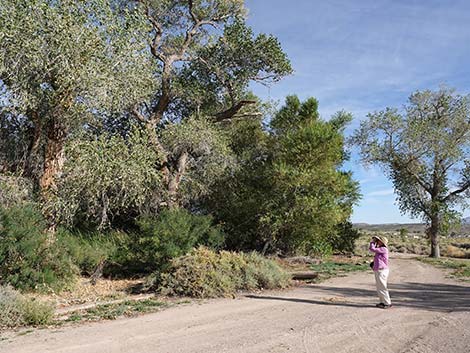 Birding at the end of the road (view N) |
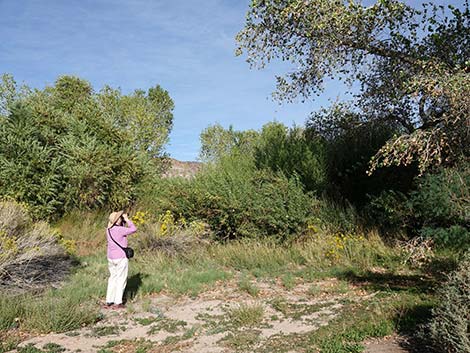 Birding around the parking area |
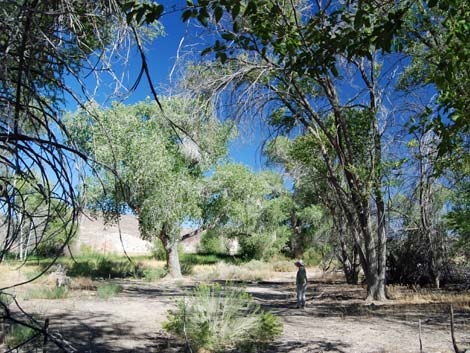 Birding around the parking area |
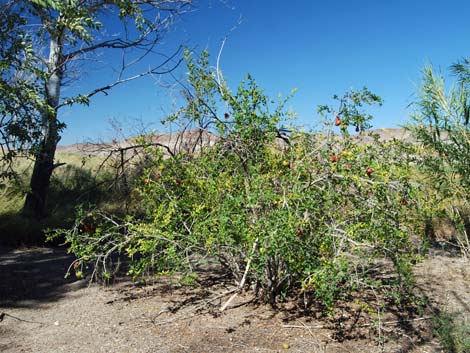 Pomegranate tree with summer fruit (view E) |
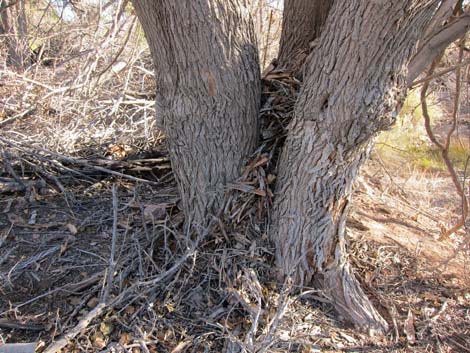 Desert Woodrat nest at base of tree |
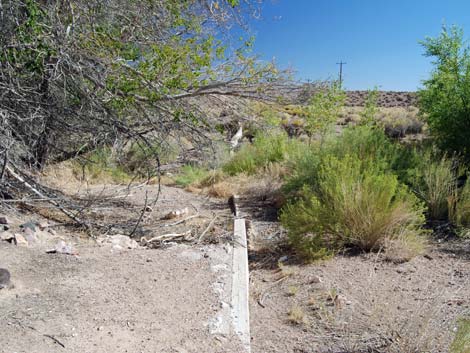 Low dam sometimes forms a pool in the wash (view W) |
Birding the Dace Pond Boardwalk Trail
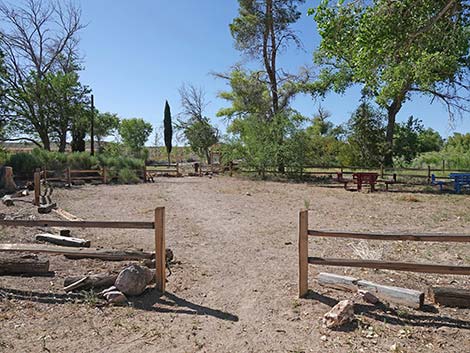 Entering picnic area at the end of the road (view N) |
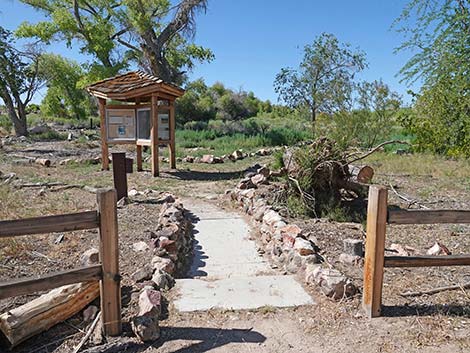 Trail starts past the picnic area by information kiosk (view N) |
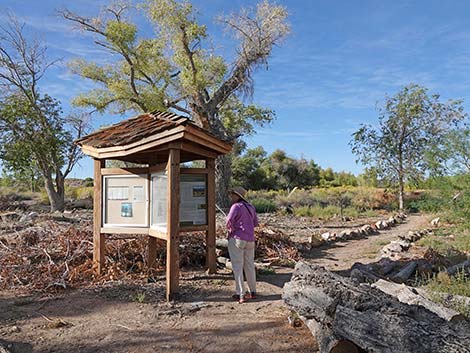 Birder at three-sided information kiosk |
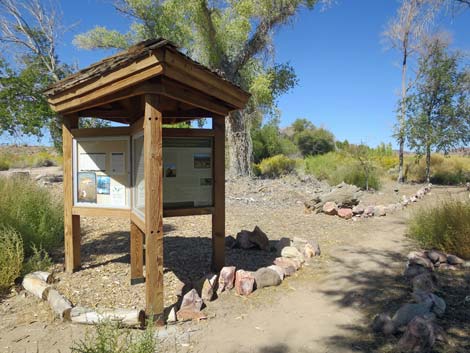 Three-sided information kiosk |
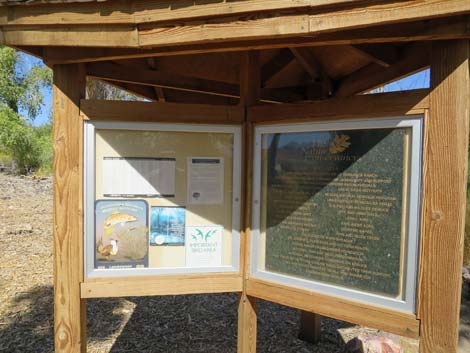 Information kiosk side 1 |
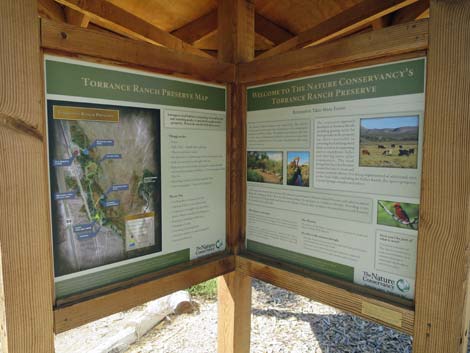 Information kiosk side 2 |
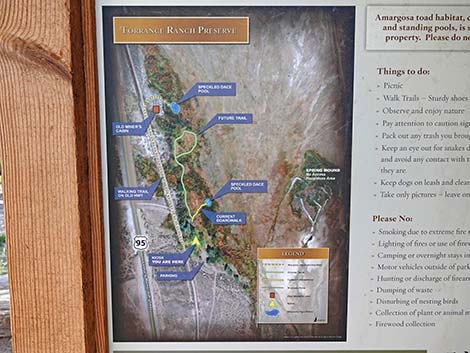 Map on information kiosk side 2 |
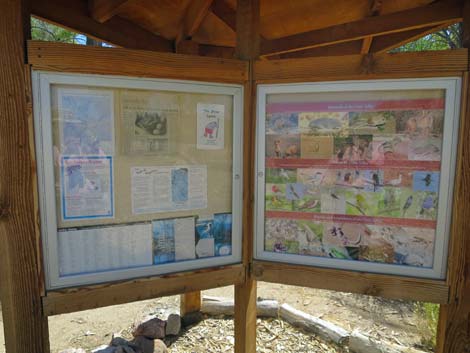 Information kiosk side 3 |
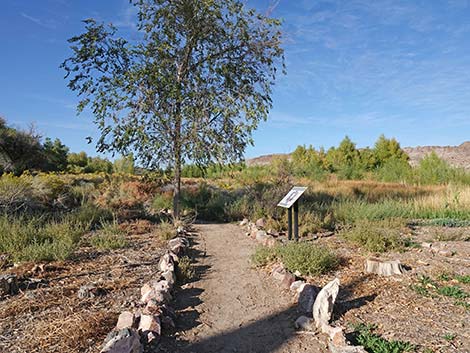 Start of the Dace Pond Boardwalk Trail |
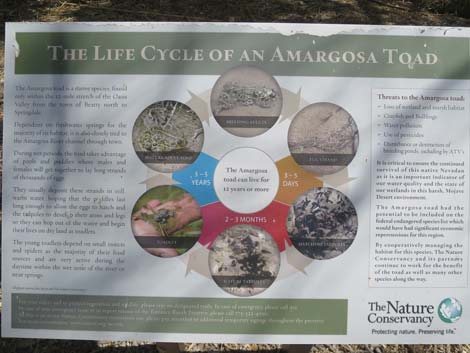 Information sign: The life cycle of an Amargosa Toad |
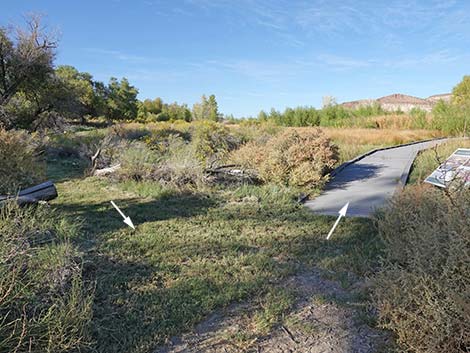 Approaching fork in trail and start of boardwalk (view NE) |
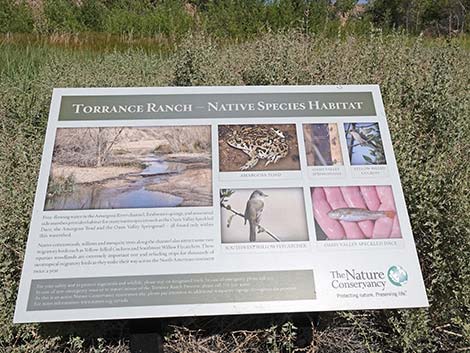 Information sign (view NE) |
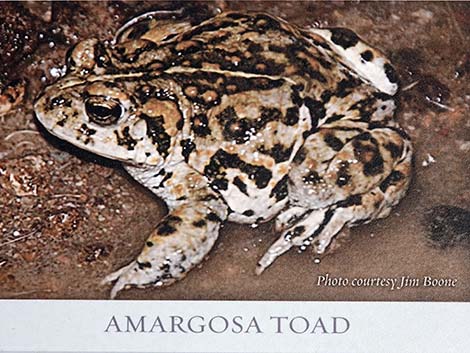 Amargosa Toad picture on information sign |
 Birder starting on the boardwalk (view NE) |
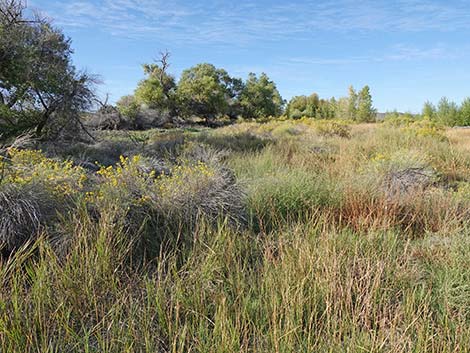 Big marsh (view N) |
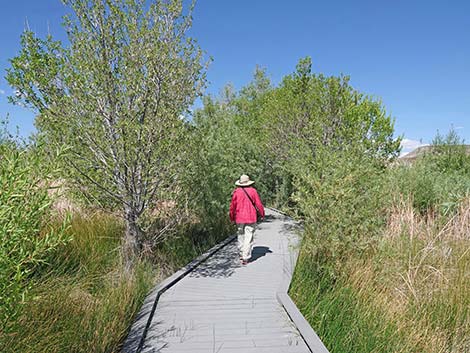 Birder on the boardwalk (view NE) |
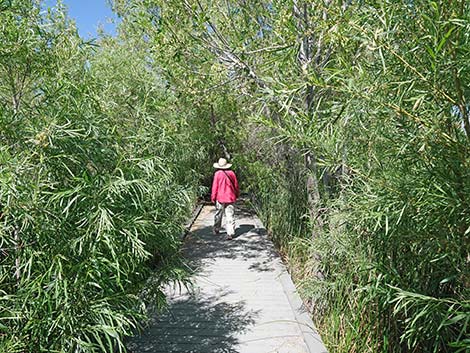 Trees growing up along the boardwalk (view NE) |
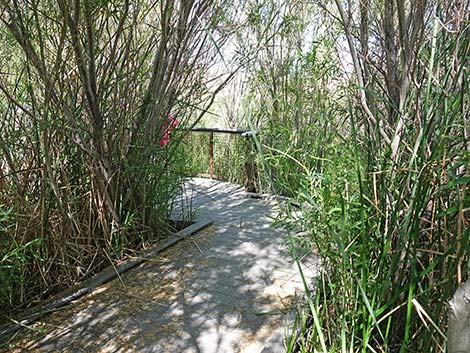 The willow trees are getting tall and thick (view NE) |
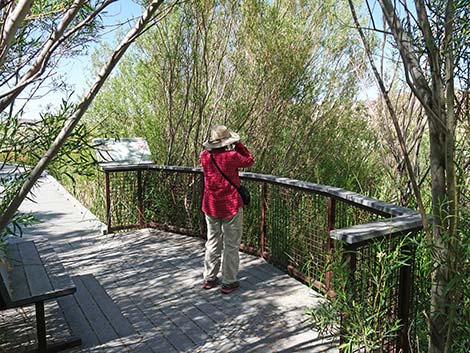 Bench and information sign along the boardwalk (view N) |
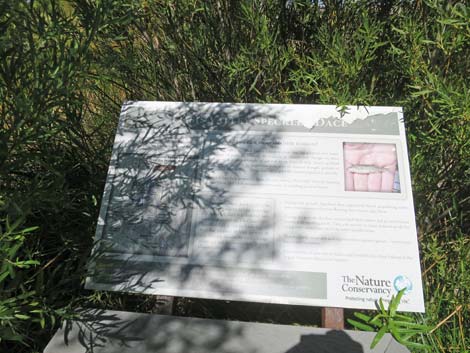 Information sign (view N) |
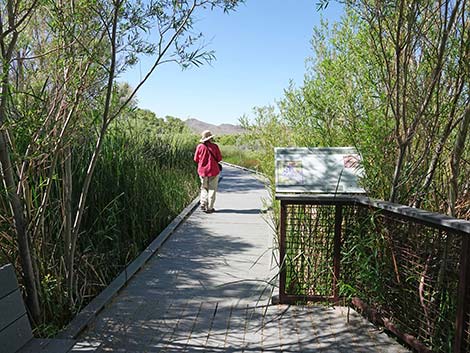 Birder exiting the willow thicket (view N) |
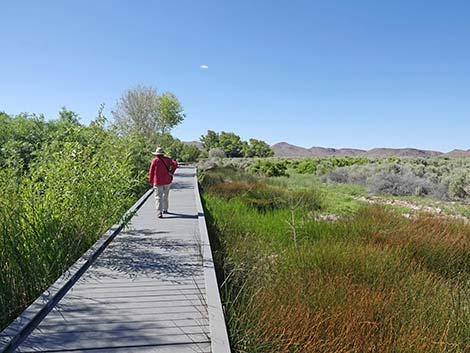 Birder on the boardwalk (view N) |
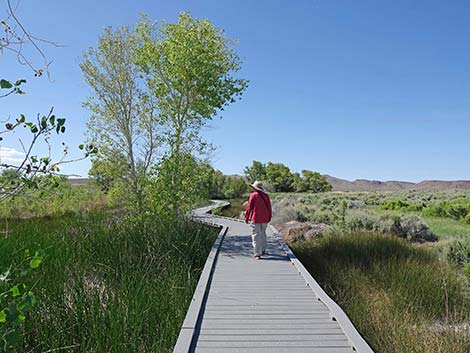 Birder on the boardwalk trail (view N) |
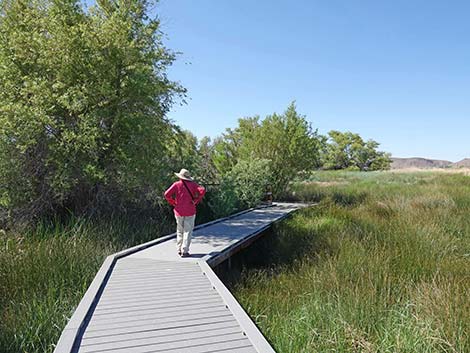 Birder on the boardwalk trail (view N) |
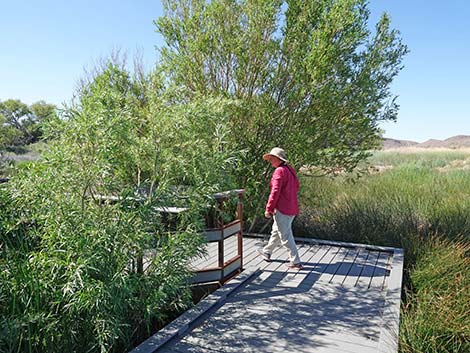 Approaching the turn-around at end of boardwalk trail (view N) |
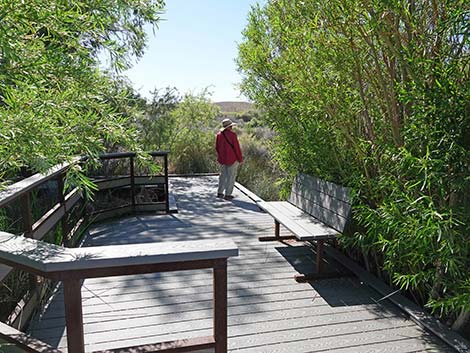 Bench at the end of the boardwalk loop (view W) |
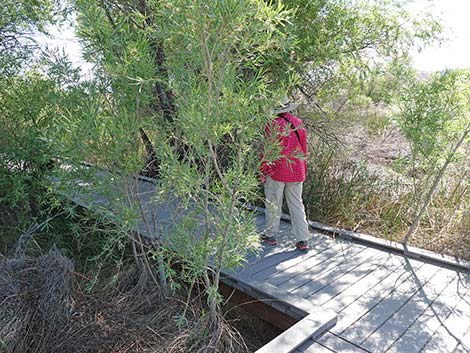 Turning back on the boardwalk (view SW) |
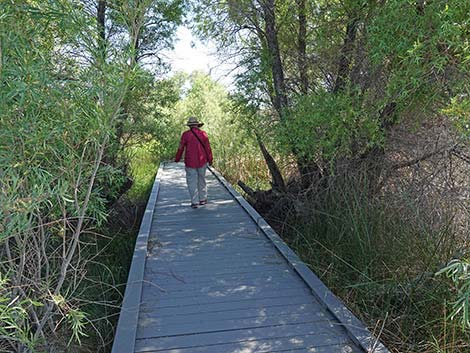 Boardwalk with more thick willows (view S) |
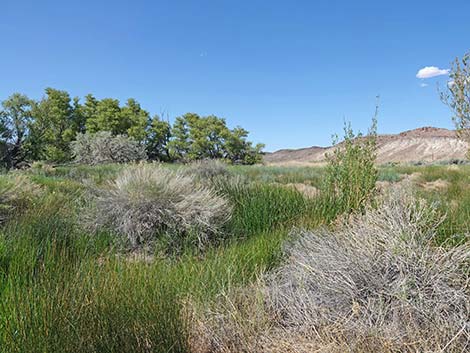 Marsh during spring (view SW) |
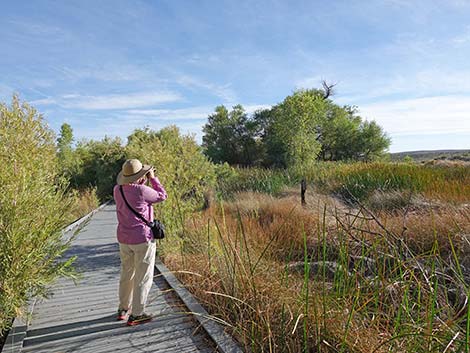 Birder scanning for marsh birds during fall (view SW) |
 Zigging and zagging on the boardwalk (view SW) |
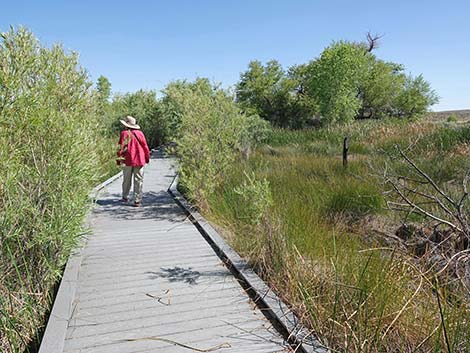 Birder on the boardwalk trail (view S) |
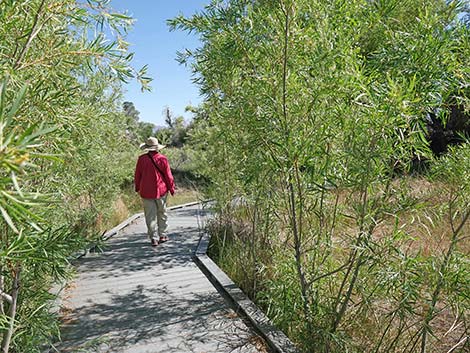 Birder walking through another willow thicket (view S) |
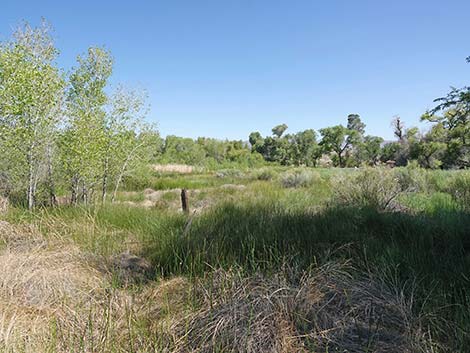 Marsh during spring (view SE) |
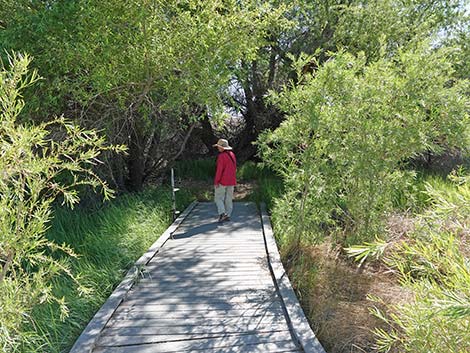 Birder at the end of the boardwalk (view SW) |
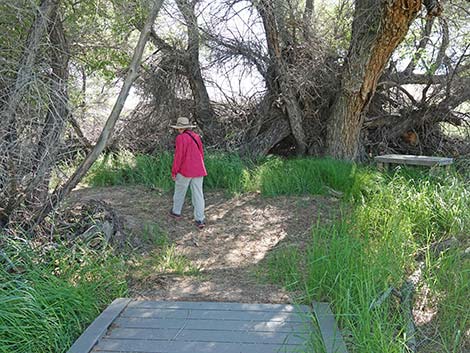 The dirt trail turns left and continues through trees (view S) |
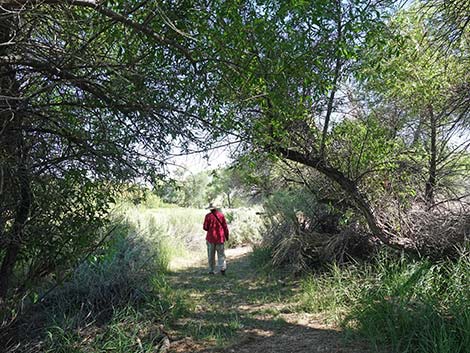 The dirt trail continues through trees (view S) |
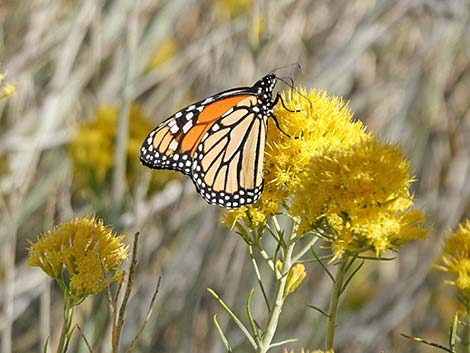 Hidden gems along the dirt trail (view E) |
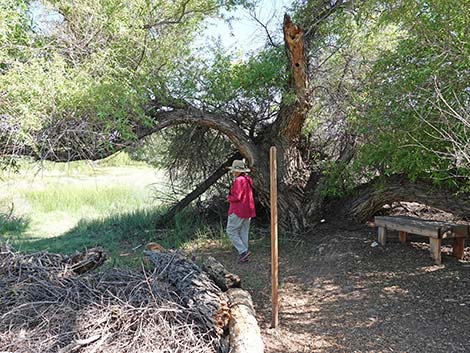 Birder passing another shady bench (view S) |
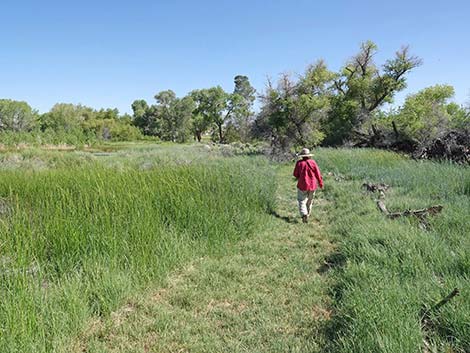 Birder on dirt trail with grass (view S) |
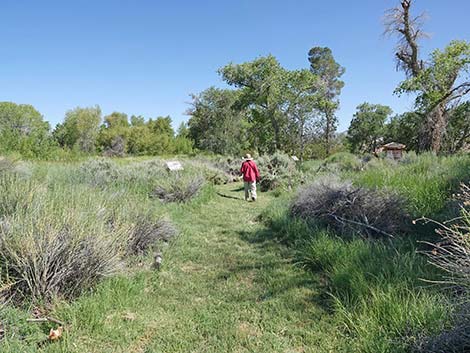 Birder closing the loop (view S) |
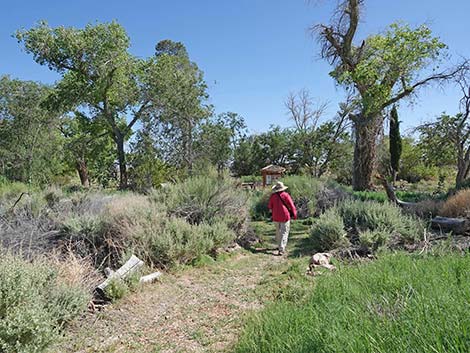 Returning back over the outbound trail (view ) |
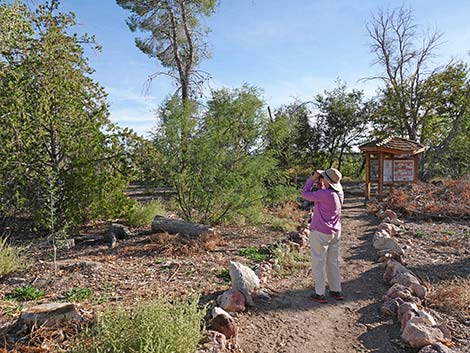 Finding more birds in the trees (view S) |
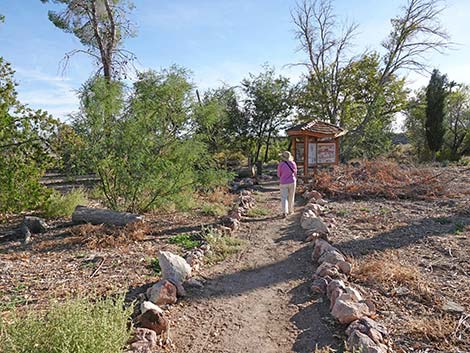 Birder returning to the 3-sided kiosk (view S) |
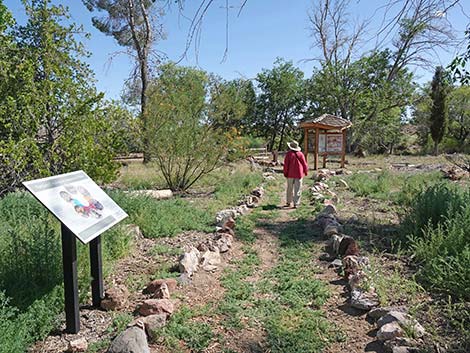 |
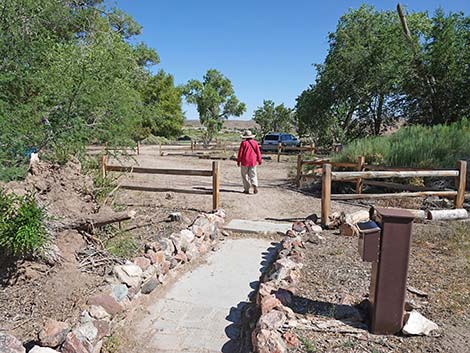 |
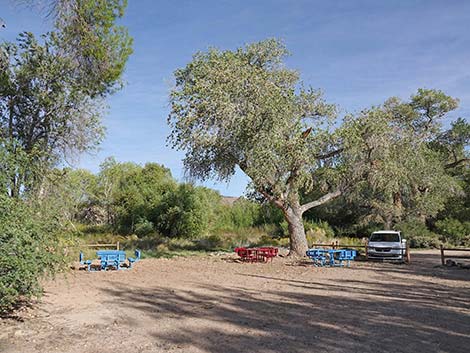 Returning back through the picnic area towards trailhead (view SE) |
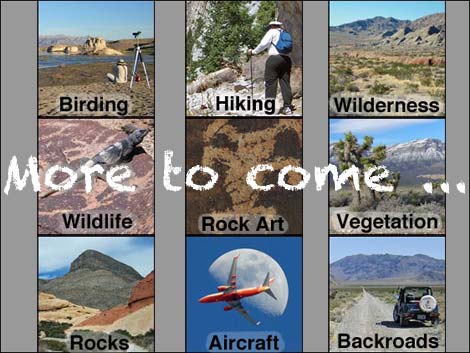 More to come ... |
Birding the Old Highway Trail
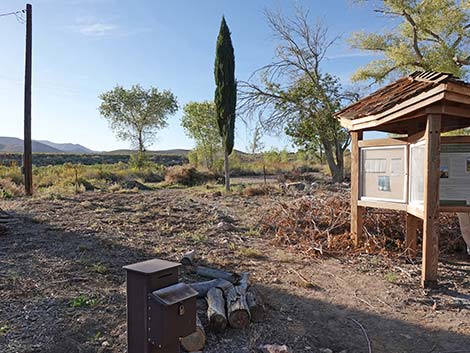 Old Highway Trail turns left at 3-sided information kiosk (view NW) |
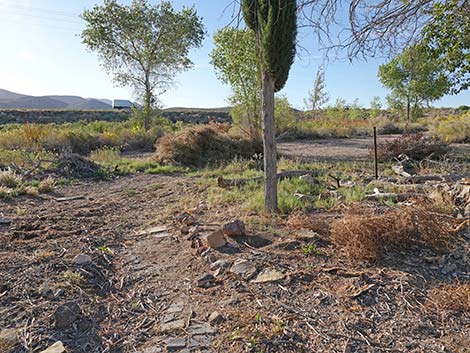 Trail starts across dirt towards the old road (view NW) |
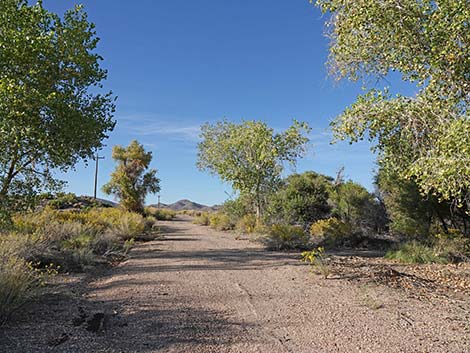 Start of the Old Highway Trail (view N) |
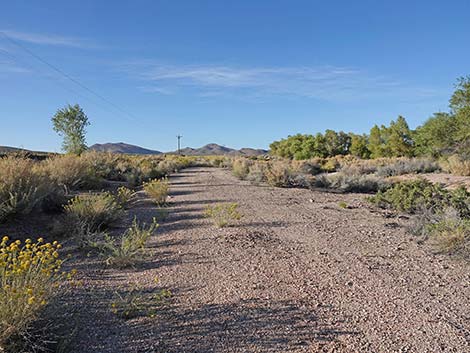 Old Highway Trail provides access to northern areas (view N) |
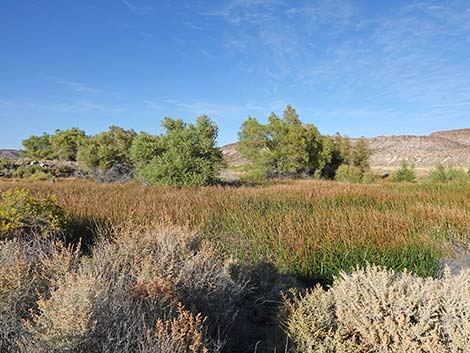 Marsh along the Old Highway Trail (view NE) |
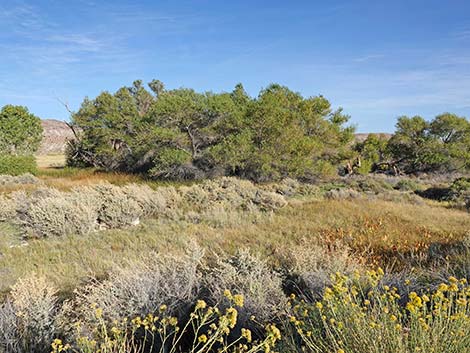 Marsh and willows along the Old Highway Trail (view E) |
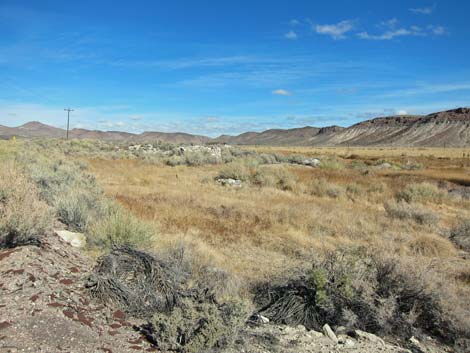 Stone cabin ruins at north end of preserve (view NE) |
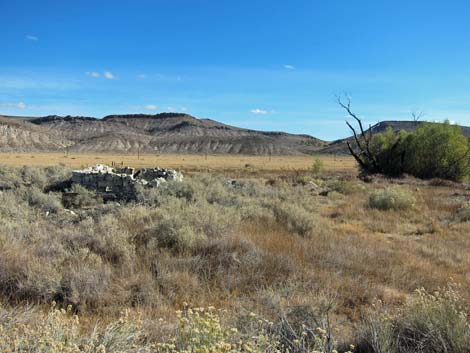 Stone cabin ruins at north end of preserve (view E) |
 Stone cabin ruins (view SE) |
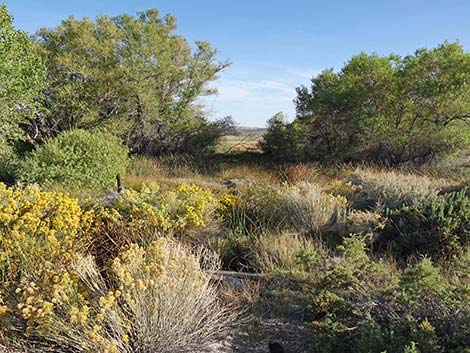 Shrubs and willow trees; water down there? (view SE) |
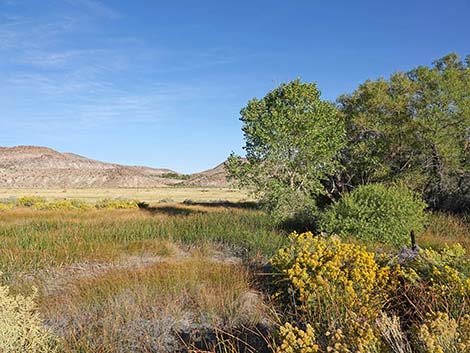 Marsh and willows (view E) |
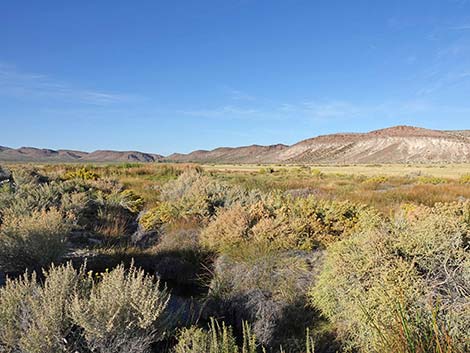 Marsh and shrubs (view NE) |
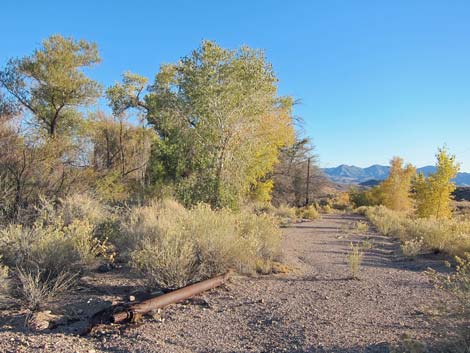 Returning down Old Highway Trail (view S) |
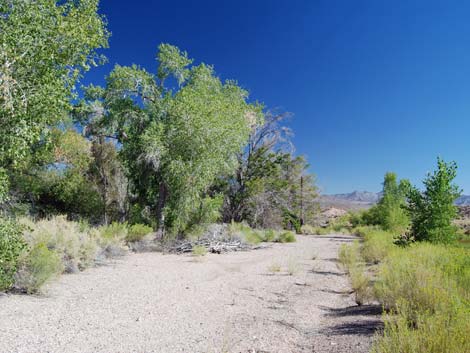 Nearing south end of Old Highway Trail (view S) |
Happy birding! All distances, elevations, and other facts are approximate.
![]() ; Last updated 240614
; Last updated 240614
| Birding Around Las Vegas | Southern Nevada Birds | Guide Service | Copyright, Conditions, Disclaimer | Home |